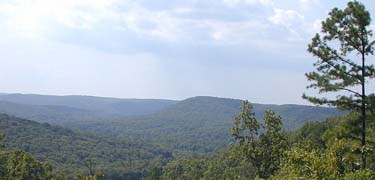
by Ron Siller The thought provoking, often simple names of Ozark places stimulate the imagination. Some place names are self explanatory, such as Ash Tree Ridge, Cedargrove and Bat Cave. Others are a little more complicated. The Encyclopedia Britannica states that the word Ozark is probably a corruption of "Aux Arc," the name of a French trading post established in the region in the 1700's. Another source has it that the Osage Indians hunted with long bows made from the wood of a tree known to the French as "Bois d'arc." Today we call it the Osage orange. Many names come from the early French explorers and trappers in the area. The trappers placed their traps in "La Riviere Courant," the "Running River." The Jacks Fork River was named by later settlers. According to local legend it is named for a Shawnee Indian named Captain Jack who camped along the river with his tribe. In the early 1800's, settlers brought animal hides to the river to process them into leather. The hides were soaked in a "tan - vat" filled with tannic acid. Later, the hides were removed from the vat and submerged in the deep water that is known to this day as Tan Vat Hole. Troublesome Hollow got its name during the turbulent Civil War years. Lawless guerrillas, known as "bushwhackers," used the hollow as a base to cause nearby settlers grief and trouble during that unsettled time. Meeting House Cave also takes its name from the Civil War period. According to legend, the cave was used as a hide-out during the war. Marauding bands from both sides of the conflict used the cave as a place to meet and lay low. Nearby Hospital Cave was supposedly used as a hospital during the war as well. In the old days, farmers drove their wagon teams down the steep western bank of the river to reach a mill. Hauling a fresh load of meal back uphill was hard on the horses. The horses stretched their harnesses to the snapping point, it was a tight pull. Thus Pulltite. Jerktail got its name from mule skinners who yelled "jerk tail" at the mules who strained hard to pull heavy loads of copper and iron ore up out of the river valley. The wagons were loaded at mines on the east side of the river. The Osage Indians once made the Current River Valley their home. An Osage chief named Cardareva is said to be buried on top of the mountain known to this day as Cardareva Bluff. Interesting and unique names add character and romance to the landscape of the Ozarks.They are a lasting record of the stories of the land. |
Last updated: April 10, 2015
